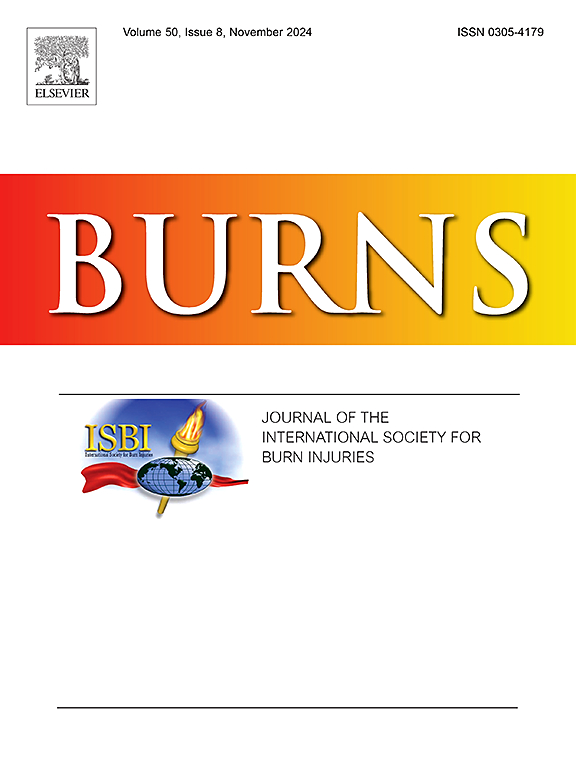The separate and combined effect of intraoperative stressors on the surgical team during burn surgery: A pilot study
IF 2.9
3区 医学
Q2 CRITICAL CARE MEDICINE
引用次数: 0
Abstract
Background
Burn injuries occurring to more than 20 % of a patient’s total body surface area (TBSA) are often treated in hot theatres and are considered complex cases, potentially increasing stress in the surgical staff. While heat stress is known to affect perceived workload and cognitive function, the effect of psychological stress, and the combined effect of heat and psychological stress, have not been explored in surgical staff. Thus, our aim was to assess the separate and combined effects of heat and psychological stress on cognitive function, perceptual measures, and physiological variables of surgical staff during burn surgery.
Methods
Eight surgical personnel were assessed in control conditions: CON (24 ± 1°C; 7 ± 10 % TBSA), hot conditions: HOT (30 ± 1°C; 18 ± 2 % TBSA), and complex, hot conditions: HOTC (32 ± 1°C; 37 ± 23 % TBSA). Cognitive function and perception of thermal sensation and comfort were recorded pre- and post-surgery, while perceived workload was assessed post-surgery only. Physiological variables were recorded throughout surgery.
Results
Working memory capacity pre-surgery (g=0.38) and processing speed were impaired in HOTC compared to CON (p < 0.05), but were not different between HOT and CON (p > 0.05). Perceived workload was higher in HOTC compared to CON (p < 0.05) but was not different between HOT and CON (p > 0.05). Numerical differences in core temperature between HOTC and CON were larger than differences between HOT and CON, while heart rate was significantly higher in HOTC compared to HOT or CON (p < 0.05).
Conclusions
Heat stress can cause symptoms of heat strain in the surgical team, which can be exacerbated by psychological stress, potentially leading to cognitive impairments and a higher perceived workload.
术中应激源对烧伤手术团队的单独和联合影响:一项初步研究
背景:烧伤面积超过患者体表面积(TBSA)的20% %,通常在热手术室进行治疗,被认为是复杂的病例,可能会增加手术人员的压力。虽然已知热应激会影响感知工作量和认知功能,但心理应激的影响,以及热应激和心理应激的联合影响,尚未在外科工作人员中得到探讨。因此,我们的目的是评估热应激和心理应激对烧伤手术人员认知功能、知觉测量和生理变量的单独和联合影响。方法8名手术人员在对照条件下进行评估:CON(24 ± 1°C;7 ± 10 % TBSA),高温条件:hot(30 ± 1°C;18 ± 2 % TBSA),以及复杂的高温条件:HOTC(32 ± 1°C;37 ± 23 %回溯)。术前和术后记录认知功能、热感觉和舒适度,术后仅评估感知工作量。在整个手术过程中记录生理变量。结果HOT组术前工作记忆容量(g=0.38)和处理速度较CON组降低(p <; 0.05),HOT组与CON组差异无统计学意义(p <; 0.05)。HOTC组的感知工作量高于CON组(p <; 0.05),但HOT组与CON组之间无差异(p <; 0.05)。HOTC组和CON组的核心温度数值差异大于HOT组和CON组的差异,而HOTC组的心率明显高于HOT组和CON组(p <; 0.05)。结论高温应激可引起手术团队热应激症状,并可因心理应激而加重,可能导致认知障碍和更高的感知工作量。
本文章由计算机程序翻译,如有差异,请以英文原文为准。
求助全文
约1分钟内获得全文
求助全文
来源期刊

Burns
医学-皮肤病学
CiteScore
4.50
自引率
18.50%
发文量
304
审稿时长
72 days
期刊介绍:
Burns aims to foster the exchange of information among all engaged in preventing and treating the effects of burns. The journal focuses on clinical, scientific and social aspects of these injuries and covers the prevention of the injury, the epidemiology of such injuries and all aspects of treatment including development of new techniques and technologies and verification of existing ones. Regular features include clinical and scientific papers, state of the art reviews and descriptions of burn-care in practice.
Topics covered by Burns include: the effects of smoke on man and animals, their tissues and cells; the responses to and treatment of patients and animals with chemical injuries to the skin; the biological and clinical effects of cold injuries; surgical techniques which are, or may be relevant to the treatment of burned patients during the acute or reconstructive phase following injury; well controlled laboratory studies of the effectiveness of anti-microbial agents on infection and new materials on scarring and healing; inflammatory responses to injury, effectiveness of related agents and other compounds used to modify the physiological and cellular responses to the injury; experimental studies of burns and the outcome of burn wound healing; regenerative medicine concerning the skin.
 求助内容:
求助内容: 应助结果提醒方式:
应助结果提醒方式:


